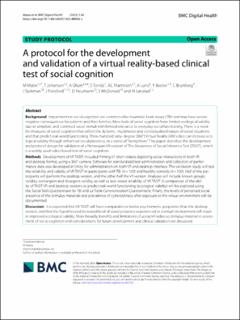| dc.contributor.author | Matre, Martin | |
| dc.contributor.author | Johansen, Truls Sveløkken | |
| dc.contributor.author | Olsen, Alexander | |
| dc.contributor.author | Tornås, Sveinung | |
| dc.contributor.author | Martinsen, Anne Catrine Trægde | |
| dc.contributor.author | Lund, Anne | |
| dc.contributor.author | Becker, Frank | |
| dc.contributor.author | Brunborg, Cathrine | |
| dc.contributor.author | Spikman, Joke | |
| dc.contributor.author | Ponsford, Jennie | |
| dc.contributor.author | Neumann, Dawn | |
| dc.contributor.author | McDonald, Skye | |
| dc.contributor.author | Løvstad, Marianne | |
| dc.date.accessioned | 2024-01-17T09:22:51Z | |
| dc.date.available | 2024-01-17T09:22:51Z | |
| dc.date.created | 2023-09-07T14:09:33Z | |
| dc.date.issued | 2023 | |
| dc.identifier.citation | BMC Digital Health. 2023, . | en_US |
| dc.identifier.issn | 2731-684X | |
| dc.identifier.uri | https://hdl.handle.net/11250/3112052 | |
| dc.description.abstract | Background Impairments in social cognition are common after traumatic brain injury (TBI) and may have severe negative consequences for patients and their families. Most tests of social cognition have limited ecological validity due to simplistic and contrived social stimuli with limited relevance to everyday social functioning. There is a need
for measures of social cognition that reflect the dynamic, multimodal and contextualized nature of social situations and that predict real-world functioning. Three hundred sixty–degree (360°) Virtual Reality (VR) video can increase eco- logical validity through enhanced social presence, or a sense of “being there”. This paper describes the development and protocol design for validation of a Norwegian VR-version of The Awareness of Social Inference Test (TASIT), which is a widely used video-based test of social cognition.
Methods Development of VR TASIT included filming 61 short videos depicting social interactions in both VR
and desktop format, using a 360° camera. Software for standardized test administration and collection of perfor- mance data was developed in Unity, for administration on both VR and desktop interface. The validation study will test the reliability and validity of VR TASIT in participants with TBI (n = 100) and healthy controls (n = 100). Half of the par- ticipants will perform the desktop version, and the other half the VR version. Analyses will include known groups validity, convergent and divergent validity, as well as test–retest reliability of VR TASIT. A comparison of the abil-
ity of TASIT VR and desktop versions to predict real-world functioning (ecological validity) will be explored using
the Social Skills Questionnaire for TBI and La Trobe Communication Questionnaire. Finally, the levels of perceived social presence of the stimulus materials and prevalence of cybersickness after exposure to the virtual environment will be documented.
Discussion It is expected that VR TASIT will have comparable or better psychometric properties than the desktop version, and that the hypothesized increased level of social presence experienced in a virtual environment will result in improved ecological validity. More broadly, benefits and limitations of using VR video as stimulus material in assess- ment of social cognition and considerations for future development and clinical validation are discussed. | en_US |
| dc.language.iso | eng | en_US |
| dc.rights | Navngivelse 4.0 Internasjonal | * |
| dc.rights.uri | http://creativecommons.org/licenses/by/4.0/deed.no | * |
| dc.title | A protocol for the development and validation of a virtual reality-based clinical test of social cognition | en_US |
| dc.type | Peer reviewed | en_US |
| dc.type | Journal article | en_US |
| dc.description.version | publishedVersion | en_US |
| cristin.ispublished | true | |
| cristin.fulltext | original | |
| cristin.qualitycode | 1 | |
| dc.identifier.doi | 10.1186/s44247-023-00036-x | |
| dc.identifier.cristin | 2173261 | |
| dc.source.journal | BMC Digital Health | en_US |
| dc.source.pagenumber | 14 | en_US |
| dc.relation.project | Norges forskningsråd: 328615 | en_US |

